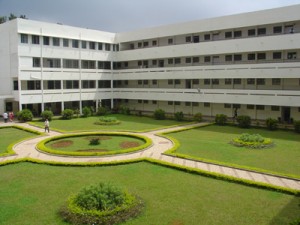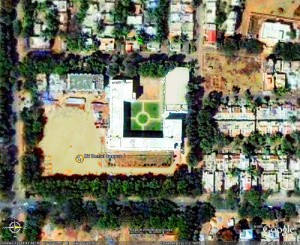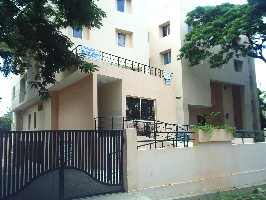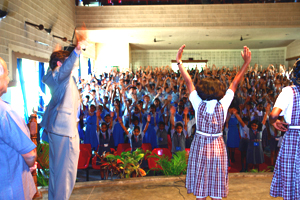Chiropractic Diplomatic Corps – Bangalore India Project
Introduction
 In March of 2004, Dr. Gary Auerbach, past and founding President of the World Federation of Chiropractic (WFC), began a dialogue at the invitation of Dr. Roberta Ritson, External Relations officer of the World Health Organization. He was queried as to the ability of the chiropractic profession to provide spinal health promotion to the urban poor in a “Healthy City Initiative” being implemented in Bangalore, India.
In March of 2004, Dr. Gary Auerbach, past and founding President of the World Federation of Chiropractic (WFC), began a dialogue at the invitation of Dr. Roberta Ritson, External Relations officer of the World Health Organization. He was queried as to the ability of the chiropractic profession to provide spinal health promotion to the urban poor in a “Healthy City Initiative” being implemented in Bangalore, India.
A Healthy City is one that is continually creating and improving those physical and social environments and expanding community resources which enable people to mutually support each other in performing all the functions of life and in developing to their maximum potential. The concept of a Healthy City Project is based on the principle that health can be improved by modification of living conditions: the physical environment, and the social and economic conditions of every day life. This holistic approach sees health as the outcome of all the factors and activities, which impact upon the lives of individual and communities.
In its ideal form the Healthy City Initiative proposes that people in a healthy city have gainful employment and a steady and sufficient income and that they have access to good health care facilities and services. They enjoy a safe water supply and sanitation facilities, garbage is collected and properly disposed of and streets are clean and paved. The city environment is free from pollution and not congested. Roads and transportation systems are safe and adequate, and the city has good communication links. The city should have ample public parks, green areas, sports grounds and recreation facilities. These are the objectives of the Healthy City Initiative promoted by the WHO and being adopted in ten major cities around the world.
In addition to the introduction of providers of chiropractic it has been recommended that the first chiropractic faculty be established in Bangalore. There are no chiropractic practitioners in the sub-continent of India. This despite the fact that India is a Mecca of many alternative/traditional healing methods with large numbers of practitioners of Ayruveda, Yoga, Naturopathy, Unani, Siddha and Homeopathy, yet it does not yet enjoy the benefits of chiropractic.
The World Health Organization (WHO) has currently completed its recommended “Guidelines on basic training and safety in chiropractic.” This historical document can be instrumental in the standardization of chiropractic education for the chiropractic profession which now exists in over 100 countries at various stages of development, and in supporting the growing demand and levels of interest for chiropractic services worldwide. This is a very timely development since so many countries are at some stage of discussions in creating a local chiropractic school.
THE PROJECT
It was evident that the application of chiropractic care would be a new and unique technology within India. Practiced with hands only, not requiring operative theatre, nor drugs or other expensive complementary elements, chiropractic would be a cost-effective evidence-based approach to dealing with difficult neuro-musculo-skeletal problems. While most English speaking countries including the United States of America, Canada, Great Britain, Australia and New Zealand have developed significant infrastructure and regulation of chiropractic practitioners, India does not have the available faculty to staff a chiropractic program.
Discussions between the Chiropractic Diplomatic Corps (CDC) and CAMHADD (Commonwealth Association for Mental Handicap and Developmental Disabilities) began. CAMHADD, established a Tri-Sector Preventive Health Care Foundation (CTPHF) as a non-profit organization whose mission is to serve urban poor of Bangalore. CAMHADD proceeded with prevention as the core aspect to the program centered on a healthy and happy family by improving quality of life through preventive and promotive health programmes at their “Healthy Lifestyle Clinics.”
Partnerships with government, private sector and civil society non-governmental organizations (NGO’s) have established promotion of health education through school health initiatives in collaboration with the World Health Organization. A healthy heart programme promoting preventive cardiology focusing on prevention of hypertension and diabetes and dental care and also lifestyle modification have established by CAMHADD jointly with Bangalore Mahanagara Palike (BMP) under their supervision with technical support from WHO and Sri Jayadeva Institute of Cardiology. R.V.Dental College is one of the Tri-sector partners.
2004 (Plan Developments)
Initial introductions and meetings were held during the World Health Assembly in Geneva in May 2004 between doctors Michel Tetrault, John Sweaney, Gary Auerbach, the Principal of the RV Dental College, Dr. K. S. Nagesh, and Dr V. R. Pandurangi, Founder, Emeritus Secretary General and International Coordinator CAMHADD. In September of 2004 Dr. Auerbach made a site visit to Bangalore and additionally met with the Vice Chancellor of the Rajiv Gandhi University of Health Sciences (RGUHS), Dr. R. Chandrashekhara leading to a formal proposal put forth by RV Dental College to the RGUHS to establish the first chiropractic faculty in India.
 Both the full Bachelor’s program and an advanced standing Fellowship program in chiropractic will result in the graduation of competent candidates in the skills and knowledge necessary to be able to accept a patient by primary contact, perform a physical examination, issue a chiropractic diagnosis from such examination and provide a chiropractic regime of care. Initial graduating classes will produce chiropractors who will become incorporated into the faculty for the ongoing full chiropractic study while others will go straight into private practice. The proposed seven year plan will produce some 200 to 300 graduates and enough teachers to staff several chiropractic schools in India.
Both the full Bachelor’s program and an advanced standing Fellowship program in chiropractic will result in the graduation of competent candidates in the skills and knowledge necessary to be able to accept a patient by primary contact, perform a physical examination, issue a chiropractic diagnosis from such examination and provide a chiropractic regime of care. Initial graduating classes will produce chiropractors who will become incorporated into the faculty for the ongoing full chiropractic study while others will go straight into private practice. The proposed seven year plan will produce some 200 to 300 graduates and enough teachers to staff several chiropractic schools in India.
During the October 2004 Association of Chiropractic Colleges conference sponsored by the WFC in Toronto, the CDC presented the Bangalore, India project with expectations of attracting participation from several DC colleges with one school taking the chief supervisory role. Faculty will be recruited to present their particular subject in Bangalore over a three to four week sabbatical as part of an intense program to qualify the first students who will be selected from other advanced health care disciplines. The conversion program process should be completed within two years during which the 4200 hour, full DC program will have been initiated.
2005 (The Curriculum) and 2006 (Spinal Hygiene)
Subsequent meetings held in Geneva (early Dec 2004), Bangalore (late Jan and early June 2005) and Sydney (mid June 2005) brought the CDC and Bangalore teams together in planning the Chiropractic School and Healthy City venture, resulting in a two year, 2200 hour conversion curriculum developed by Dr. Charmaine Korporaal from South Africa’s Durban Institute of Technology, Chiropractic Department, and approved by RGUHS in early Spring, 2005. Funding the project has attracted interest from the longstanding Rashtreeya Sikhshana Samithi Trust and from the newly formed India Association of Chiropractic Doctors. Application for the federal government’s approval for the course (s) has been submitted to the appropriate government agency and remains pending before a final timeline and start date can be determined.
 In the meantime Dr. Nagesh has visited several chiropractic campuses: Macquarie University Chiropractic Department, in June while attending the WFC Congress as a guest of the WFC; and the Life West and Palmer West facilities in September while attending a conference at Stanford University in the San Francisco Bay area. In Bangalore, facilities for classrooms and clinic space have been reserved at a Rashtreeya Sikhshana Samithi Trust property for the coming chiropractic college purposes. (photo right) Principal, Dr. Nagesh, continues to have great passion for housing the chiropractic training program in Bangalore.
In the meantime Dr. Nagesh has visited several chiropractic campuses: Macquarie University Chiropractic Department, in June while attending the WFC Congress as a guest of the WFC; and the Life West and Palmer West facilities in September while attending a conference at Stanford University in the San Francisco Bay area. In Bangalore, facilities for classrooms and clinic space have been reserved at a Rashtreeya Sikhshana Samithi Trust property for the coming chiropractic college purposes. (photo right) Principal, Dr. Nagesh, continues to have great passion for housing the chiropractic training program in Bangalore.
At present we continue to patiently wait for the government approval. The slow approval process has also necessitated the training of a few dozen Spinal Screeners to begin the neuromusculoskeletal evaluation of Bangalore’s civic sector workers in the Tri-Sector urban poor hospital clinics. This training takes place in early November, 2005 by the executives of the Chiropractic Diplomatic Corps. The subsequent screenings will be documented as a part of the ongoing WHO affiliated research under the supervision of Dr. Vasu Pandurangi of CAMHADD that, when compiled, will bring substantial information about the real needs of the local population that will be incorporated into the formal training of chiropractors in India. Spinal Screenings are performed by volunteers trained by the Chiropractic Diplomatic Corps and additional training sessions were held in June 2006 in Bangalore and Hubli, Karnataka.
2007 (Straighten Up! India)
 Dr. Vasu Pandurangi of CAMHADD has secured additional support from Life Chiropractic College by attracting the interest of Dr. Ron Kirk in developing a Straighten Up! India campaign. This spinal hygiene signature program, originally initiated by Dr. Sid Williams at the WHO Assembly in 2002 while President of Life University, has already met much success in the USA and Australia, with additional developments in South Africa and now in India.
Dr. Vasu Pandurangi of CAMHADD has secured additional support from Life Chiropractic College by attracting the interest of Dr. Ron Kirk in developing a Straighten Up! India campaign. This spinal hygiene signature program, originally initiated by Dr. Sid Williams at the WHO Assembly in 2002 while President of Life University, has already met much success in the USA and Australia, with additional developments in South Africa and now in India.
February 2007 was the inaugural presentation of the Straighten Up! India activities when Dr. Kirk was the keynote speaker at a Bangalore and Karnataka conference on Workers’ Health and Occupational Safety. Chiropractic continues to be invited to contribute its special healthcare focus in the state of Karnataka, India.
 The highlight of the trip was the teaching and demonstration of the Posture Pod exercise cluster to some 500 high school students as shown in the photo on the right. Dr. Kirk is also seen on the left involving the adult population, the city and the state leaders, in performing these “Flying three” spinal hygiene exercises. A research project with protocols to quantify the correction of improper postural “forward translation” is being processed for screening activities by the CTPHF volunteers in two Bangalore City public sector employee hospital centres.
The highlight of the trip was the teaching and demonstration of the Posture Pod exercise cluster to some 500 high school students as shown in the photo on the right. Dr. Kirk is also seen on the left involving the adult population, the city and the state leaders, in performing these “Flying three” spinal hygiene exercises. A research project with protocols to quantify the correction of improper postural “forward translation” is being processed for screening activities by the CTPHF volunteers in two Bangalore City public sector employee hospital centres.
An additional plan for 2007 in advancing the interests of chiropractic in India is to attract 1-2 DCs into establishing private practices in Bangalore, with much support pledged by the CAMHADD and the Tri-Sector Preventive Health Care Foundation, and with assistance by the Chiropractic Diplomatic Corps in recruiting appropriate candidates that can also further the humanitarian activities already in play. Chiropractors seeking to practice in India could do no better than this by leveraging on the existing on-the-ground support fostered these past three years during these ongoing efforts. Please register online at chiropracticdiplomatic.com/register and then email the CDC director at [email protected].